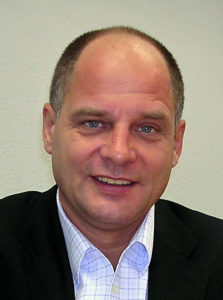
- Facharzt für Laboratoriumsmedizin
- Apl. Professor für Angewandte Immunologie an der Universität Heidelberg
- Gründer, Geschäftsführer und Inhaber der ImmBioMed Business Consultants GmbH & Co. KG
- Inhaber der LOXO GmbH
Michael Kramer wurde 1958 in Jugenheim geboren und studierte von 1977 an Medizin an der Universität Heidelberg. 1985 erhielt er seine Approbation als Arzt und im gleichen Jahr promovierte er an der Universität Heidelberg zum Dr. med. 1992 erhielt er die Venia Legendi für „Angewandte Immunologie“ an der Universität Heidelberg. 1999 wurde er als Facharzt für Laboratoriums-Medizin und die Zusatzbezeichnung „Ärztliches Qualitäts-Management“ zugelassen. Dazu erwarb er 2000 noch die Zusatzbezeichnung „Transfusions-Medizin“. Im Dezember 1999 wurde er zum Professor (apl.) für Angewandte Immunologie an der Universität Heidelberg ernannt. Michael Kramer ist verheiratet und hat zwei Kinder.
Berufliche Stationen und Geschäftsentwicklung
1979 – 1985 Studentische Hilfskraft am Deutschen Krebsforschungszentrum in Heidelberg
1985 – 1987 Militärdienst am Zentralinstitut des Sanitätsdienstes der Bundeswehr in Koblenz
1987 – 1998 Verschiedene Kliniken und Institute des Heidelberger Universitätsklinikums; davon 1992 -1998 Oberassistent am Institut für Immunologie der Universität Heidelberg und Leiter des Laboratoriums für Immunpathologie
1999 – 2003 Geschäftsführer der LYNX Therapeutics GmbH in Heidelberg; ein Tochterunternehmen der Lynx Therapeutics Inc., Hayward, CA, USA
ab 2003 Gründung und Entwicklung der ImmBioMed Business Consultants GmbH & Co. KG
ab 2007 Gründung und Aufbau einer Laborarzt-Praxis in Heidelberg
08/2017 Erwerb der LOXO GmbH (www.loxo.de)
03/2018 Erwerb des Geschäftsbereichs „Specialty Coagulation“ der Sekisu Diagnostics GmbH (Pressemeldung)
Wissenschaftliche Preise
1985 Julius-Redel-Preis der Medizinischen Fakultät der Universität Heidelberg
1989 Paul-Gersson-Unna-Preis der Deutschen Dermatologischen Gesellschaft
1998 Robert-Pfleger-Preis für Biomedizinische Forschung
Ausgesuchte Publikationen
Kramer, M.D., L. Binninger, V. Schirrmacher, H. Moll, M. Prester, G. Nerz, and M.M. Simon. 1986
Characterization and isolation of a trypsin-like serine protease from a long-term culture cytolytic T cell line and its expression by functionally distinct T cells.
Immunol. 136:4644-4651.
Simon, M.M., H. Hoschützky, U. Fruth, H.-G. Simon, and M.D. Kramer. 1986
Purification and characterization of a T cell specific serine proteinase (TSP-1) from cloned cytolytic T lymphocytes.
EMBO J. 5:3267-3274.
Kramer, M.D. and Simon M.M. 1987
Are proteinases functional molecules of T lymphocytes?
Immunology Today 8:140-142.
Kramer, M.D., U.E. Schaible, R. Wallich, S.E. Moter, D. Petzoldt, M.M. Simon. 1990
Characterization of Borrelia burgdorferi associated antigens by monoclonal antibodies.
Immunobiol. 181:357-366.
Schaible, U.E., M.D. Kramer, K. Eichmann, M. Modolell, C. Museteanu, and M.M. Simon. 1990
Monoclonal antibodies specific for the outer surface protein A (OspA) of Borrelia burgdorferi prevent Lyme borreliosis in severe combined immunodeficiency (scid) mice.
Proc. Natl. Acad. Sci. USA 87:3768-3772.
Simon M.M., U.E. Schaible, R. Wallich, and M.D. Kramer. 1991.
A mouse model for Borrelia burgdorferi infection: approach to a possible vaccine against
Lyme disease.
Immunology Today 12:11-16.
Kramer, M.D. and J. Reinartz. 1993.
The autoimmune blistering skin disease bullous pemphigoid: The presence of plasmin/
a2-antiplasmin complexes in skin blister fluid indicates plasmin generation in lesional skin.
Clin. Invest. 92:978-983.
Reinartz J., R. Batrla, P. Boukamp, N. Fusenig, and M.D. Kramer. 1993.
Binding and activation of plasminogen at the surface of human keratinocytes.
Exp. Cell Res. 208:197-208.
Fuchs H., R. Wallich, M.M. Simon, and M.D. Kramer. 1994.
The outer surface protein A of the spirochete Borrelia burgdorferi is a plasmino(gen) receptor.
Proc. Natl. Acad. Sci: USA 91: 12594-12598.
Moter, S.E., H. Hofmann, R. Wallich, M.M. Simon, and M.D. Kramer. 1994.
Detection of Borrelia burgdorferi sensu lato in lesional skin of erythema migrans and acrodermatitis chronica atrophicans by OspA-specific polymerase chain reaction.
Clin. Microbiol. 32:2980-2988.
Foekens J.A., F. Buessecker, H.A. Peters, U. Krainick, W.L.J. van Putten, and M.D. Kramer. 1995.
Plasminogen activator inhibitor-2 (PAI-2): prognostic relevance in 1012 patients with primary breast cancer.
Cancer Res. 55:1423-1427.
Fuchs H., M.M. Simon, R. Wallich, M. Bechtel, and M.D. Kramer. 1996.
Borrelia burgdorferi induces the secretion of pro-urokinase-type plasminogen activator by human monocytes.
Infect. Immun. 64:4307-4312.
Bechtel M. J., J. Rox, S. Inndorf, J. Reinartz, B. Schaefer, and M.D. Kramer. 1996.
Upregulation of cell surface-associated plasminogen activation in cultured keratinocytes by Interleukin-1beta and Tumor-Necrosis-Factor-alpha.
Exp. Cell. Res. 223:395-404.
Schaefer B., C. Jaeger, E. Drepper, and M.D. Kramer. 1996.
Plasminogen activation in bullous pemphigoid. Immunohistology revels uPA, uPA-R, and PAI-2 in lesional epidermis.
Autoimmunity 23:155-164.
Schaefer B.M., J. Reinartz, M.J. Bechtel, S. Inndorf, E. Lang, M.D. Kramer. 1996.
Dispase-mediated basal detachment of cultured keratinocytes induces urokinase-type plasminogen activator (uPA9 and its receptor (uPA-R, CD87).
Exp. Cell. Res. 228:246-253.
Schaefer M.D., C. Jaeger, and M.D. Kramer. 1996.
The plasminogen activator system in pemphigus vulgaris.
Br. J. Dermatol. 135:726-732.
Schott D., C.-E. Dempfle, P. Beck, A. Liermann, A. Mohr-Pennert, M. Goldner, P. Mehlem, H. Azuma, V. Schuster, A.-M. Mingers, H.P. Schwarz, and M.D. Kramer.1998
Therapy with a purified plasminogen concentrate in an infant with ligneous conjunctivitis and homozygous plasminogen deficiency.
New Engl. J. Med. 339:1679-1686.
Kontakt
ImmBioMed Business Consultants GmbH & Co. KG
Bergstraße 85
64319 Pfungstadt
Telefon: +49 171 956 3808
Telefax: +49 6157 86443
E-Mail: info@immbiomed.de
Skype: profmdkramer